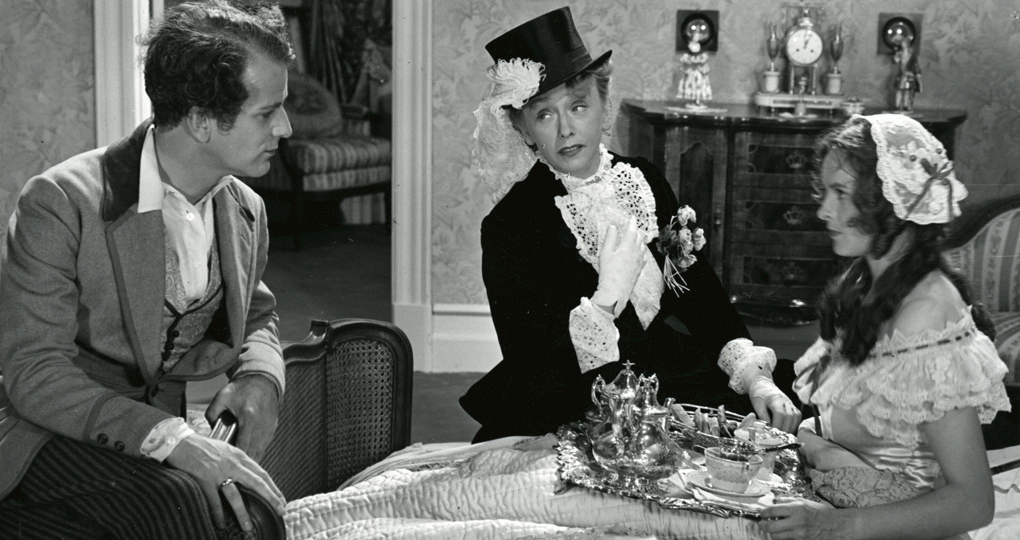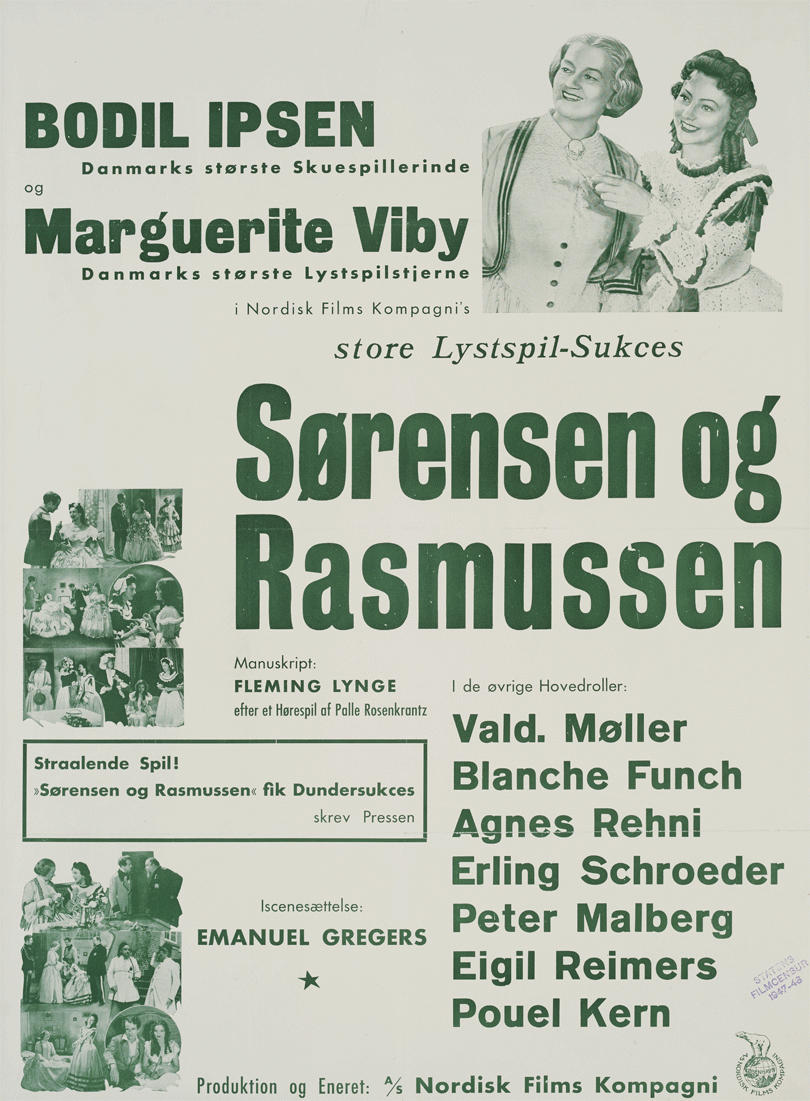
The Danish film Sørensen og Rasmussen opened on 28 September 1940, a little less than six months after Denmark had been occupied by Nazi Germany on 9 April. With one possible exception (Mille, Marie og jeg, 1938/literally: Mille, Marie and I), it was the biggest box office hit the film company Nordisk Film had had, at least for the decade since the coming of sound. It was also favourably received by critics, and it has retained its status as a minor classic. It stars two great female actors, Bodil Ipsen (described in the film’s publicity as “Denmark’s greatest actress”) and Marguerite Viby (described as “Denmark’s greatest comedy star”). The two actors play well off each other, and both give very fine performances.

Sørensen og Rasmussen is a comedy of class and disguise; it is also a costume picture, set in the 1850s and featuring a couple of historical figures among the leading characters. This places it among several films made during 1940 that emphasize national themes, and the way it connects comedy and nationalism makes it an interesting case study. It is a recognized minor classic, one of the 136 key works given special treatment in the survey volume 100 års dansk film (‘One Hundred Years of Danish Film’). In that volume, film historian Eva Jørholt calls it “consummately Danish” (Jørholt 2001, 124), a phrasing also used by the critic Morten Piil (2008, 542). Danes like to see themselves as humorous, un-deferential, and permissive, and these are precisely the virtues that the film celebrates. The film is worth a closer look, not least for the ingenious way it links these virtues to Danish national and cultural history and democratic traditions, but also because it is a witty and well-acted comedy.
I will start out by introducing the film and giving a few details about the production. I will then discuss the film’s reception, focusing first on a particularly interesting reaction to Marguerite Viby’s performance and then on one of the few strongly voiced critiques: it attacked the film for inappropriately and unpatriotically making King Frederik VII a figure of ridicule. Between these two points, I will examine how the original radio play on which the film was based was adapted for the screen. I will then go on to examine other reactions to the film that instead see its comedy as something particularly Danish.
Royalty with the Common Touch
The film’s opening credits are followed by a title card introducing King Frederik VII. Frederik VII is probably the best-known pre–20th Century Danish monarch. In 1849, during the first Schleswig war, he granted Denmark’s first democratic constitution, and, somewhat curiously, remains the single historical figure that most clearly embodies and symbolizes the birth of Danish democracy and democratic nationalism. His equestrian statue in front of the parliament building in Copenhagen was financed by popular subscription and bears the king’s well-chosen motto: “The people’s love is my strength”.
In 1850, Frederik VII entered into a morganatic marriage with a former dancer and dressmaker named Louise Rasmussen, who was ennobled as Countess Danner. A photograph of the couple was acquired by Nordisk and used to publicize Sørensen og Rasmussen. One newspaper published this photograph next to a still from the film under a headline reading “Film and reality” (Politiken, 21 July 1940).
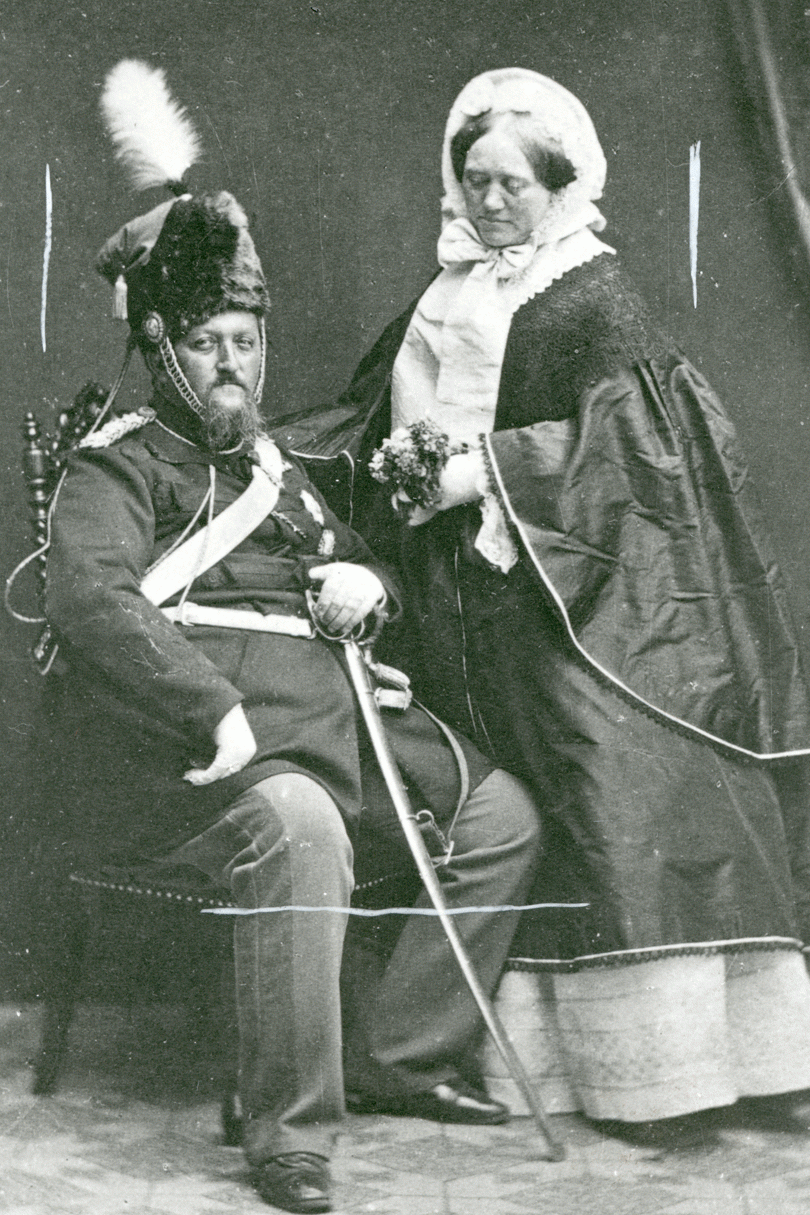
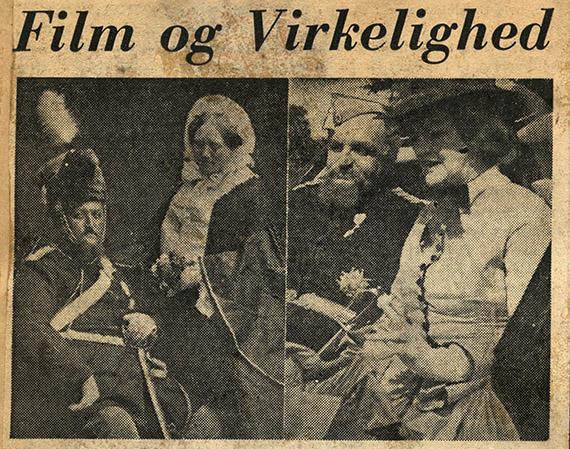
A film still was made that closely matched the famous portrait of the King and the Countess painted in 1861 by J.V. Gertner (now at Jægerspris Slot).
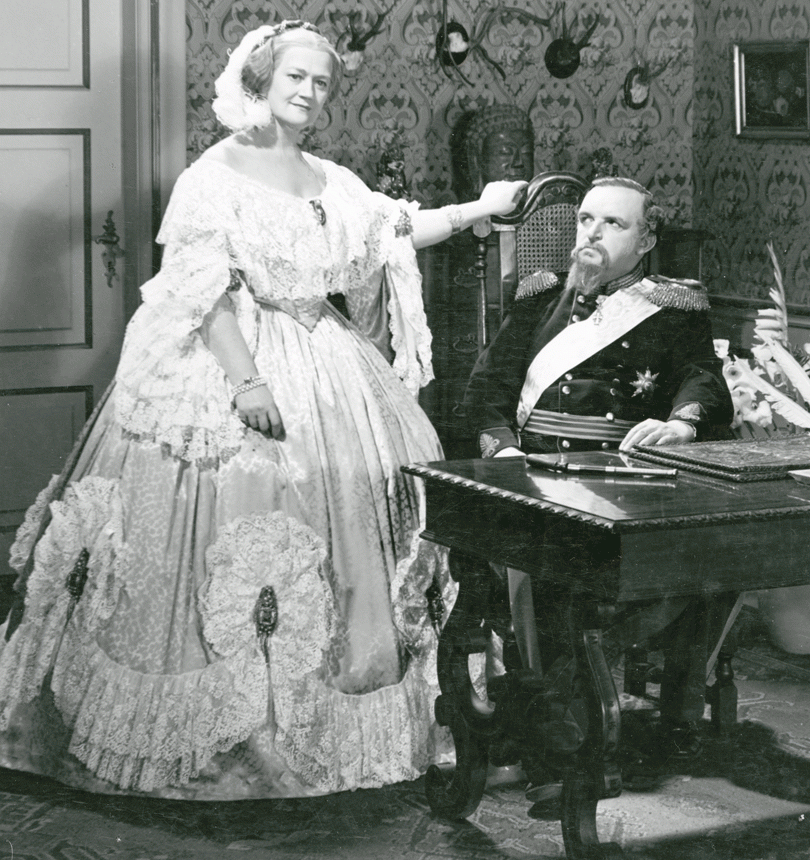
This, too, was circulated by Nordisk along with a photograph of the original painting, and the images were published side-by-side both in promotional material published by Nordisk and in the newspaper B.T. (23 September 1940).
Sørensen og Rasmussen begins with the royal couple travelling through the countryside of Jutland.

The king (played by Valdemar Møller) is portrayed in the film as an easy-going and broad-minded fellow, if not overly bright. His wife, the Countess Danner (Bodil Ipsen), is equally broad-minded, but also possessed of keen intelligence and sharp wit. The plot of the film turns on the contempt many of the high-born characters hold for the King’s wife, a mere commoner.
Mrs. Parsberg (Blanche Funch), the wife of a young country squire (Erling Schroeder), wishes to avoid having to curtsy before Countess Danner and kiss her hand. She decides to change places with her housemaid, who is consistently referred to by her last name, Sørensen (Marguerite Viby).


As one might expect, the spirited Sørensen cuts a charming figure as the lady of the manor, and Mrs. Parsberg must endure various amusing indignities in her housemaid disguise. Sørensen’s common sense, zest, un-snobbish humor, and basic sense of fairness allow her to connect with the royal couple, who have similar personalities.

The film’s title underscores its populism. In Denmark, names ending in -sen are originally patronymics that were converted into surnames in the 18th century in towns and in the 19th century in the country (Meldgaard 2008). Even today, more than 50 per cent of Danes have a surname ending in -sen, and of the 20 most common surnames, only the nineteenth is not a -sen-name. The names Sørensen and Rasmussen are number 8 and 9 on the list ("personnavn" 2009). A -sen-name suggests that its bearer belongs to the common people.
The film makes this theme quite explicit. The high-born ladies share a pamphlet with a cruel ballad that mocks Countess Danner as a trollop and plays on her common last name, Rasmussen, by nicknaming her “Rasmusina."
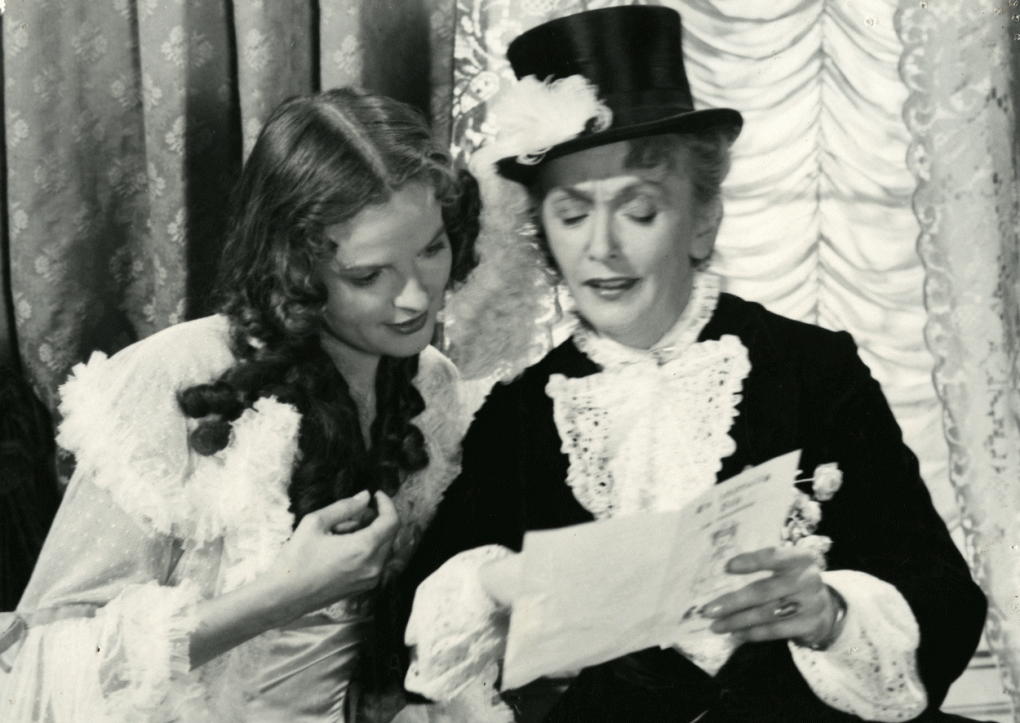
When she discovers the humiliating pamphlet in the bag of one of the ladies, Baroness von Eckerts (Agnes Rehni), the Countess turns the tables on the contemptuous gentry by singing the ballad aloud herself.
The housemaid, Sørensen, is in love with a handsome lieutenant, Vilhelm Stahlfeldt (Pouel Kern), who is the brother of her mistress, Mrs. Parsberg. To Mrs. Parsberg, the social difference between her high-born brother and the housemaid makes such a union utterly unacceptable.
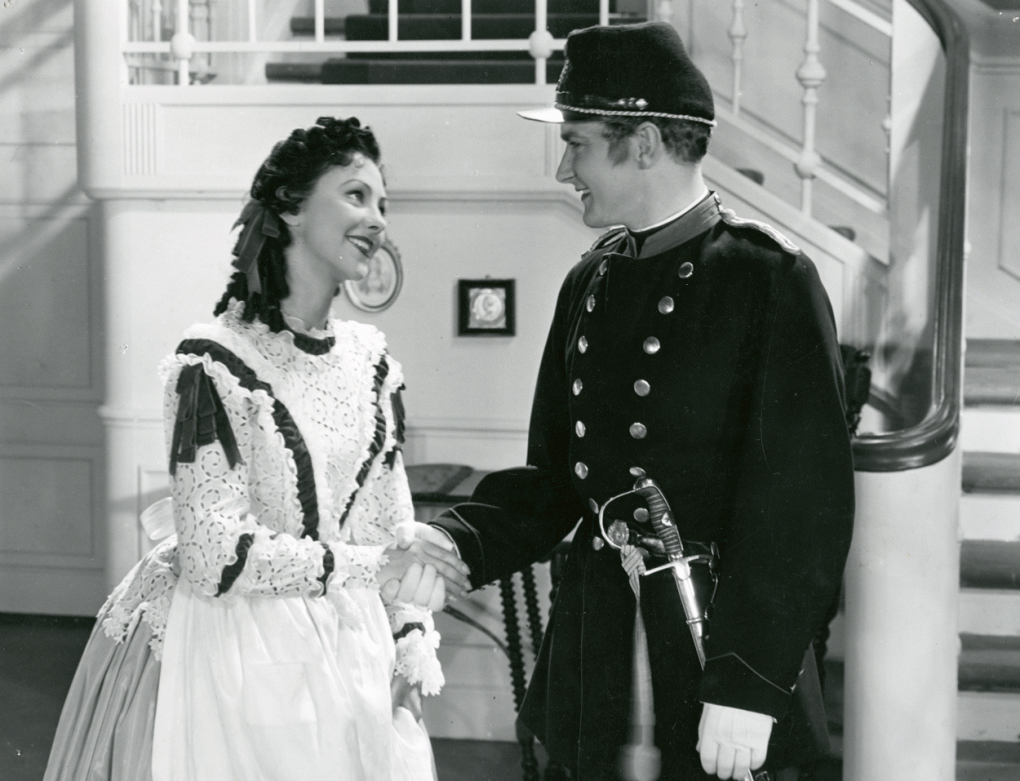
The king’s underhanded, skirt-chasing aide-de-camp Brummerstedt (Eigil Reimers), annoyed at having his attempts at bedding the supposed Sørensen frustrated, discovers the disguise plot and exposes it to Countess Danner, who is furious at Mrs. Parsberg for her snobbishness and deception.

The next morning, Sørensen, now a housemaid again, brings the Countess breakfast. (Fritz is the Countess’ affectionate nickname for the King).
Clip: Sørensen og Rasmussen (Emanuel Gregers, Nordisk Films Kompagni, 1940).
The Countess, her anger tempered by her wish to help Sørensen overcome the social barriers preventing her from marrying the man she loves, keeps Mrs. Parsberg’s insulting behaviour secret from the King in exchange for her acquiescence to the marriage between her brother and Sørensen, engineering a happy ending for everyone involved.
A Plastic Performance
Documents from the company archives of Nordisk Film allow the production history to be followed quite closely. The company’s production plans would generally follow the theatrical season, running from autumn to spring: during the summer, as much of the following year’s production as possible would be shot, especially exteriors requiring sunshine. Exterior shooting began on 9 July 1940, not much more than a month after the script had been approved by the management. In her discussion of the film, Eva Jørholt remarks on the intensely idyllic character of cinematographer Poul Eibye’s sun-drenched images of waving cornfields and thatched farmhouses (Jørholt 2001, 124). Nordisk’s top studio cinematographer Valdemar Christensen then shot the interiors, beginning on 3 August. Shooting was completed on 22 September, just six days before the premiere (NF X, 176).
The film’s director was Emanuel Gregers, a reliable and efficient veteran (he directed his first film in 1913). His direction is un-flashy and workmanlike: there are no surprising shots or angles, and the cut-ins to close-ups are not always smooth. Still, Gregers is not afraid of the obvious theatricality of the plot machinery with its disguises and parallelisms. At the end, he even allows Bodil Ipsen a final tableau that overtly stages her role as the wise overseer of the action who ensures that everything is put right at the end. She smiles benignly when Mr. and Mrs. Parsberg reveal that they have taken her advice and begun making babies; with one hand, the Countess literally pushes Sørensen into the arms of her lieutenant, and with the other, she makes the skirt-chasing aide-de-camp look the other way as both couples embrace and kiss. The set-up may be completely artificial, but it is charming, elegant, and well-timed.
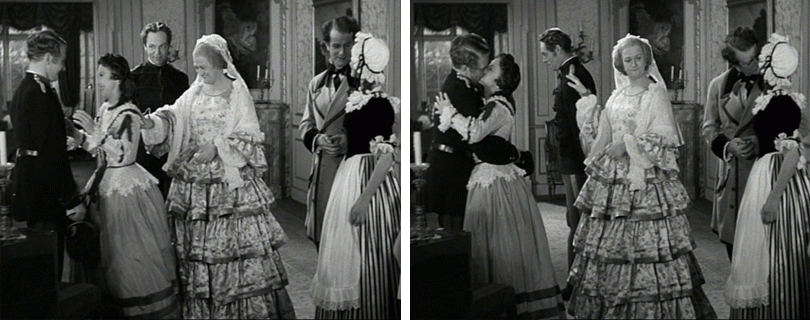
Gregers got excellent performances from his actors, and the production does not appear to have experienced any difficulties despite the potentially awkward circumstance that both Ipsen and Viby were Gregers’ ex-wives (he was married to the former from 1919 to 1923, and to the latter from 1932 to 1938). According to Viby’s recollections, at a party following the film’s opening night, Gregers gave a gracious speech thanking his collaborators, prompting Ipsen to toast Viby with the words: “Cheers, little Viby, our husband is doing a damn fine job!” (Mørk 2001, 92).
Unsurprisingly, most of the contemporary reviewers also focused on the performances. One of the most interesting responses to the film came from the famous literary scholar Vilhelm Andersen, who in 1908 had become the first full professor of literary history at the University of Copenhagen. Andersen, now nearly eighty, wrote a little piece for Masken, a short-lived glossy magazine about theatre and film, in which he praised the performance of Marguerite Viby in Rasmussen og Sørensen, as he carelessly calls the film. It is a rather affected piece, in which he wistfully invokes having been a “professional” theatre critic “nearly half a century ago”; but now, with both his hearing and his eyesight failing, he gets “most enjoyment from the movies” (Andersen 1941, 49). Despite these rather arch musings, Andersen manages to be both insightful and evocative in his remarks about Viby’s performance.
He calls it "plastisk", meaning "belonging to the plastic arts" or, more freely, "well-rounded" or “well-defined.” The word is also found in German — plastisch — and the art historian Heinrich Wölfflin uses it more or less synonymously with linear. Wölfflin contrasts both terms to malerisch, “painterly,” as part of his scheme of five fundamental stylistic dichotomies: the pairing of plastisch and malerischsets the notion of sharp contours in opposition to atmospheric diffusion (Wölfflin 1991, 277). In his short piece, Vilhelm Andersen invokes the etymology of the word: it was originally used of clay that had been kneaded so well that it could be used for modeling figures. He then goes on to say of Viby's characterization:
"It was an unusually well-kneaded figure: firm to the touch, face and speech as one, simple in the noblest sense of the word with no speck of the crude, and about it a fragrance of naturalness as of freshly washed linen. Watching it made my soul feel cleansed, my heart light." (Andersen 1941, 50)
Andersen writes that in comedy, “we are most like ourselves” (Andersen 1941, 50), which may seem a confusing thing to say, but I believe the implicit comparison is with tragedy, which in the 19th-century tradition required poetic diction and carefully choreographed, formalized gestures. To Andersen, Viby’s performance can be linked to the more naturalistic side of the Danish stage comedy tradition, one that de-emphasized make-up and mannerisms and was characterized by “blessed moderation, the beautiful equilibrium between outside and inside” (Andersen 1941, 50).
When watching Sørensen og Rasmussen today, Viby may not strike us as particularly naturalistic, even though her style stands in effective contrast to the grander manner of Ipsen. It is worth noting, however, that Viby takes what is basically the stock comedy figure of the clever chambermaid and gives it a definite character of her own. Viby gives Sørensen the good nature, good sense, and good-humoured frankness that wins over the King and the Countess. Sørensen is competent without being stiff; she is intelligent, but without guile. In the radio play on which the film was based (of which more in the next section) the character engages in some cheeky repartee, but the film carefully avoids the stereotype of the saucy maid. Sørensen smiles easily, but not suggestively; Viby manages the difficult trick of making Sørensen lively and open without being flirtatious.
That is not to say that the character is a naïf; during the big party at the manor, pretending to be the lady of the house, she sings “Jens og Sofie,” a popular ballad-style song (written for the film) about a sweet girl and a faithless soldier. She sings the slightly risqué text in a way that shows that she understands full well what it is all about, but the jolly, knowing delivery avoids salaciousness, instead underscoring Sørensen’s cheerful, down-to-earth personality.
From Radio to Screen
Sørensen og Rasmussen was conceived from the start as a vehicle for Viby, probably the biggest Danish film star at the time.
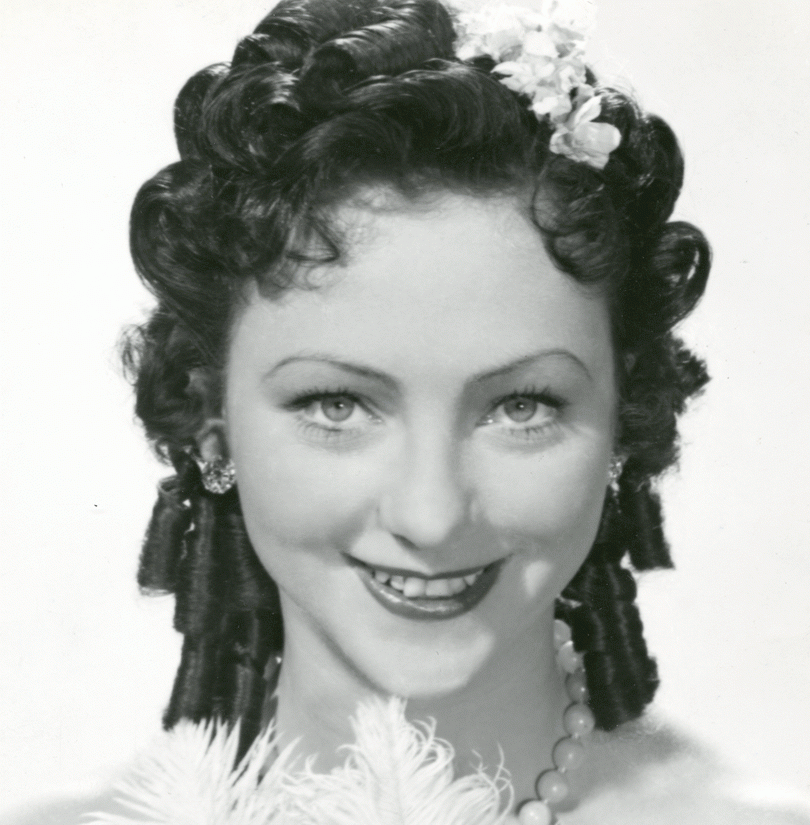
When Nordisk Film was laying plans for the 1940/41 season in the fall of 1939, a Viby vehicle was part of the line-up, but in early February 1940, a suitable property had not yet been found. According to the minutes of a production conference held on 6 February, it was decided that top scriptwriter Fleming Lynge would first write another film and then the Viby picture, “the material for which must be obtained in the meantime” (NF VIII, 19:10). Eventually, the company decided to adapt a radio play called simply Sørensen, first broadcast on Danish state radio on 8 December 1939 and re-broadcast on 19 April 1940. This seems to have been the first time in Denmark a radio drama was turned into a film.
Somewhat paradoxically, considering the populist bent of the story, Sørensen was written by a baron. Palle Rosenkrantz was a scion of one Denmark’s oldest and most illustrious noble families (Shakespeare used the surname, of course, for a character in Hamlet), but as a penniless law clerk, he contrived to become a professional author and popular novelist, “one of Denmark’s most prolific writers by page count” (Agger 1984, 189). He is perhaps best remembered for Hvad Skovsøen gemte(The Secret of the Forest Lake) from 1903, generally considered the first Danish detective novel. From 1911, he was also involved with different film companies as a screenwriter and publicist.
Sørensen was reviewed in only one of the Copenhagen dailies, but the review there was quite enthusiastic:
"Last night Palle Rosenkrantz put paid to the fable that it is hard to be funny on the radio. He managed it without the slightest difficulty. The situations progressed and followed one after another with great gusto, they were exploited with tremendous skill, and on top of that, the author had drawn the portraits of the king and Countess Danner with quite a brilliant sense of whimsy." (Berlingske Tidende, 9 December 1939)
The job of turning Sørensen into a film script was given to Fleming Lynge, one of the most prolific Danish screenwriters: of a total feature film production of 77 films during the 1930s, Lynge wrote 27, one-third of the total. He probably wrote the script during April and May 1940: on 4 June 1940, his adaptation of Rosenkrantz’s radio play was ready and read out to the company management. The decision to proceed with it must have been taken almost immediately: the casting of the major roles was announced to the press during the next few days (none of the actors had appeared in the radio play), and production began just over a month later.
Ejnar Black, Bodil Ipsen’s husband, took part in the meeting on 4 June and declared Lynge’s screenplay to be “the best Danish movie script” to date (NF VIII, 19:14). His reaction was probably not unconnected to the fact that Lynge’s script had expanded the role of Countess Danner considerably compared to the radio play, giving Bodil Ipsen ample opportunity to shine: the film’s most famous scene, where she sings the “Rasmusina” ballad, was added for the film. It is a brilliant showcase for Ipsen; she recites as much as she sings, tasting the words, throwing out asides between the verses, using the very theatricality of the scene as part of the effect – Countess Danner is performing, showing off her courage by fearlessly and openly confronting all the whispers behind her back; but occasionally, her fury at the humiliating, hurtful words boils to the surface, revealing how much she has to endure. The ballad itself was newly written; the real anti-Countess ballads were apparently so scurrilous that they would not have gotten past the film censor (B.T., 30 September 1940). The film’s script leaves out the most offensive words; Ipsen pauses, and the rhyming words let us guess that she has left un-sung certain words like “rump,” “behind,” and “slut.”
Another change made by Lynge was to give less emphasis than the radio play to a sub-plot involving the excavation of an ancient barrow mound that turns out to be an old turnip heap. Frederik VII was famously enthusiastic about archaeology, and his antiquarian interests appear as a plot point in both Sørensen and Sørensen og Rasmussen: the King initially decides to pay Parsberg a visit to examine an important collection of antiquities assembled by Parsberg’s father-in-law, and he stays on to excavate a nearby barrow (which turns out not to be ancient at all). In the film, the excavation never really gets underway, but the radio play has the whole final act take place at the dig site. Rosenkrantz uses the motif of the heritage of the ancients to have the King express a populist nationalism that is quite hostile to parliamentary democracy:
[The King:] "You see, there is nothing in the world as wonderful as digging into a venerable barrow like that. You know how heavily the wellbeing of our people weighs upon our shoulders. We have voluntarily given our people the precious gift of liberty. The people’s love is my strength, but those donkeys over in Parliament keep squabbling, while my ministers just squawk and come and go like sailors in a portside public-house. When all that gets to be too agitating, I grab my spade and start digging in the beloved earth of my fatherland, soaked as it is by the precious blood of its sons. "(Rosenkrantz 1939, 27-28)
Lynge was writing his script in the immediate aftermath of the German occupation of Denmark on 9 April 1940, threatening the very existence of Danish democratic institutions, and he wisely got rid of Rosenkrantz’s unsettling comparison of elected ministers to whoring sailors. Lynge also added the powerful dialogue scene excerpted above, where Countess Danner looks to a future where people named Sørensen and Rasmussen will be calling the shots.
In Dark Times
Again and again, the film’s reviewers referred to Sørensen og Rasmussen as “folkelig”, popular in the genuine, down-to-earth sense. The meaning of “folkelig” also shades into “national” in some contexts, like the German “völkisch”, but while the words are at root the same, the Danish word has managed to evade the chauvinistic connotations of the German and remains a term of praise. It is also used by a later film historian like Ib Bondebjerg who writes that the film’s popularity “consisted in its celebration of earthy, vigorous Danishness and populism [folkelighed] and solidarity across class divisions” (Bondebjerg 1995, 101).
Part of the film’s populism consisted in making the King a figure of fun, but this also occasioned some of the few criticisms levelled at the film, which was otherwise enthusiastically received. When the film was released, the popularity of the Danish monarchy was unprecedentedly high: King Christian X was regarded as a symbol of the nation. In a confusing and difficult situation where Denmark was a sovereign state on paper, but occupied by and subject to Nazi Germany in practice, expressing one’s loyalty to the King was a useful outlet for people hesitant to openly express their dismay at the occupation, their desire to resist the German invaders, or their disdain for the Danish politicians kow-towing to them. A documentary compilation about Christian X was one of the most successful films of 1940.
In Sørensen og Rasmussen King Frederik VII, having lost some of the grandiloquent lines given him in Rosenkrantz’ radio play, is presented as big-hearted and easy-going, but also buffoonish and Falstaffian; a decent but rather thick-headed fellow who would be lost without the shrewd countess to tell him what to think. Several reviewers wrote that this portrayal fitted with the image of the king in popular memory, but one, the influential Frederik Schyberg (also a leading drama critic), wrote that the figure of the King “was treated with more disrespect than one might expect” (Politiken, 29 September 1940).
Emanuel Gregers, the film’s director, addressed this critique when he gave an interview on the occasion of the film’s premiere in his hometown of Horsens a week later:
"We have stylized the characters, focused the telescope on the field of view within which posterity regards the characters. If disrespect has been shown to the person of Frederik VII, this disrespect is not founded on facts about the King’s life, but on the qualities ascribed to him in the memory of him. The collection of memoirs that speak of this King is a rich and above all, far from boring. " (Horsens Folkeblad, 8 October 1940)
This did not halt complaints about the film’s disrespect for royalty, however.
One of the most strongly voiced examples was written by the schoolman Olav Helstrup-Andersen. He was the headmaster of the After-School at Skanderup ("Historien" n.d.). After-Schools were schools set up in the latter part of the 19th century to provide further voluntary education for young people, mostly from rural backgrounds, who had left school at 14 as was common then. After-Schools were directed at 14-18-year-olds, unlike the similar "højskoler", High Schools, which were directed at adults. After-Schools were particularly common in the area of Jutland just north of the new border with Germany; the disastrous defeat in the Second Schleswig War in 1864 meant that large numbers of Danish-speakers in northern Schleswig came under German rule, and their children were forced to go to German schools. The After-Schools just north of the border were designed to give Danish-speaking children instruction in Danish language and culture, and thus had a mission and a curriculum with a strongly nationalist flavour.
Without mentioning the occupation explicitly, Helstrup-Andersen describes it as a time requiring earnestness and the cultivation of a shared national culture:
"Our country and our people are living in dark times, deadly serious times, when we must give up all the frivolousness we lived in before. When it will be day again, we do not know. But we might well agree to gather round all the things we as Danish people possess and have in common, that which makes us Danish in name and spirit: our history, our literature, our schools and congregations -- all that ties us together and should give us strength and warmth exactly in a time like the one we are living through." (Helstrup-Andersen 1940)
From this perspective, Helstrup-Andersen is dismayed by the comic portrayal of the king:
"Therefore it pains me to see in a Danish film shown in a Danish movie theatre that Frederik VII is caricatured as a drunkard, a slow-witted individual, a Jeppe-like simpleton who can freely be led by the nose, in other words: a pathetic figure, and yet he was Denmark’s king in a time not unlike ours." (Helstrup-Andersen 1940).
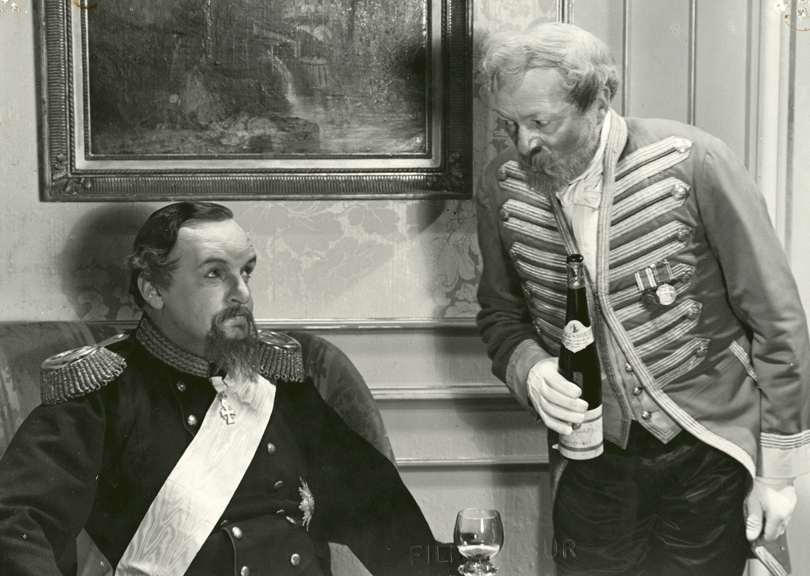
Helstrup-Andersen goes on to enumerate the historical King’s many qualities, particularly his foundational role in turning Denmark into a free democratic nation.
"This man they try to turn into a pitiful ninny at a time when laughter ought to be banished far, far underground. No, good people, that is indecent, impermissible, un-Danish!" (Helstrup-Andersen 1940)
Helstrup-Andersen’s critique was noted and discussed in other newspapers, but did not find much support. Most other reviewers saw the film’s affable monarch as a sympathetic figure, his wine- and beer-swilling evidence of his common touch and of a piece with the disdain for pretension the movie celebrates. Indeed, the style of Sørensen og Rasmussen’s humour was seen as peculiarly Danish and for that reason particularly appropriate for a “dark” time when the very survival of the nation was in doubt. The most explicit example I have found is an unsigned notice from Assens Amts Avis, a small provincial paper, reviewing the film two months after the Copenhagen premiere:
"There are quite obvious reasons for the cordial reception the Danish film Sørensen og Rasmussenreceived. It is the homely Danish sense of fun, the warm-heartedness that overcomes all prejudice, and the mutual understanding which permeates this popular [folkelig] comedy and reflect three positive aspects of the Danish national character, features which are a source of strength today." (Assens Amts Avis, 28 January 1941)
Again, we have the oblique reference to “today”; the particular aspects of that present moment which call upon the strengths of the Danish national character remain unspecified, but the German occupation cannot fail to spring to mind.
Terms of Endearment
Various elements of the movie seem deliberately intended to evoke this connection between Danishness and humour. In particular, there are elements that connect the film with the plays of Ludvig Holberg. The Norwegian-born Holberg (1684-1754) is a towering figure in Danish letters, a rationalist and early champion of enlightenment. His stage comedies, 33 in all, have historically been regarded as a national treasure in Denmark, giving him a position perhaps comparable to that of Molière (an important influence) in French literature. Pretension brought low by healthy common sense is a recurring theme of many of Holberg’s comedies, where high-falutin’ outsiders are defeated by sensible community values (Andersen 2001, 192). Common sense and hostility to pretension are among the virtues Danes most like to think of as characteristically Danish, and Sørensen og Rasmussen certainly celebrates these norms.
A comparison of Sørensen og Rasmussen with Holberg was made by at least one contemporary reviewer when he noted that the character of Sørensen “has quite a bit of Pernille in her” (Social-Demokraten, 29 September 1940). Pernille is a recurring character who appears in several of Holberg’s plays, a clever chambermaid who is paired with the wily footman Henrik. In one of the plays featuring the crafty pair, entitled Henrik og Pernille, not knowing each other, they both disguise themselves as their respective master and mistress and try to seduce each other, hoping to gain wealth and status by marrying under false pretenses. The plot device of masters and servants changing places is of course an ancient one, and Holberg uses it frequently. It also appears in the play Maskerade, which in 1905 formed the basis of the composer Carl Nielsen’s most successful opera Maskerade. The libretto for the opera (which also incorporated motifs from other Holberg plays) was written by the literary scholar Vilhelm Andersen. The text emphasizes how the carnival and the wearing of disguises bring a healthy liberation from the bonds of hierarchy:
"The masked cavalcade rushes forth
Along with freedom and equality
Along with the meanest clod and the richest lord
They follow; no wonder that so do we." (Quoted from Jensen 1991, 247)
Henrik and Pernille also appear in the opera Maskerade, and at one point Henrik seeks to woo Pernille with an aria bearing the title “Min søde Balsambøsse”, “My sweet pomander”. A pomander is a small container with aromatic substances inside. These were most popular in the 16th and 17th centuries; even as a term of endearment, it has a very archaic air when it re-appears in a 20th-century context: Sørensen og Rasmussen.
In the following scene, which appears about five minutes into the film, the young squire Parsberg quarrels with his haughty and unloving wife, whom he calls “my pomander”:
Clip: Sørensen og Rasmussen (Emanuel Gregers, Nordisk Films Kompagni, 1940).
The odd, archaic quality of the term is suggested by the abbreviated version of the screenplay published in 1943 or thereabouts by the Swedish Folkuniversitet, a sort of Open University, for the purpose of Danish language instruction for Swedish speakers.
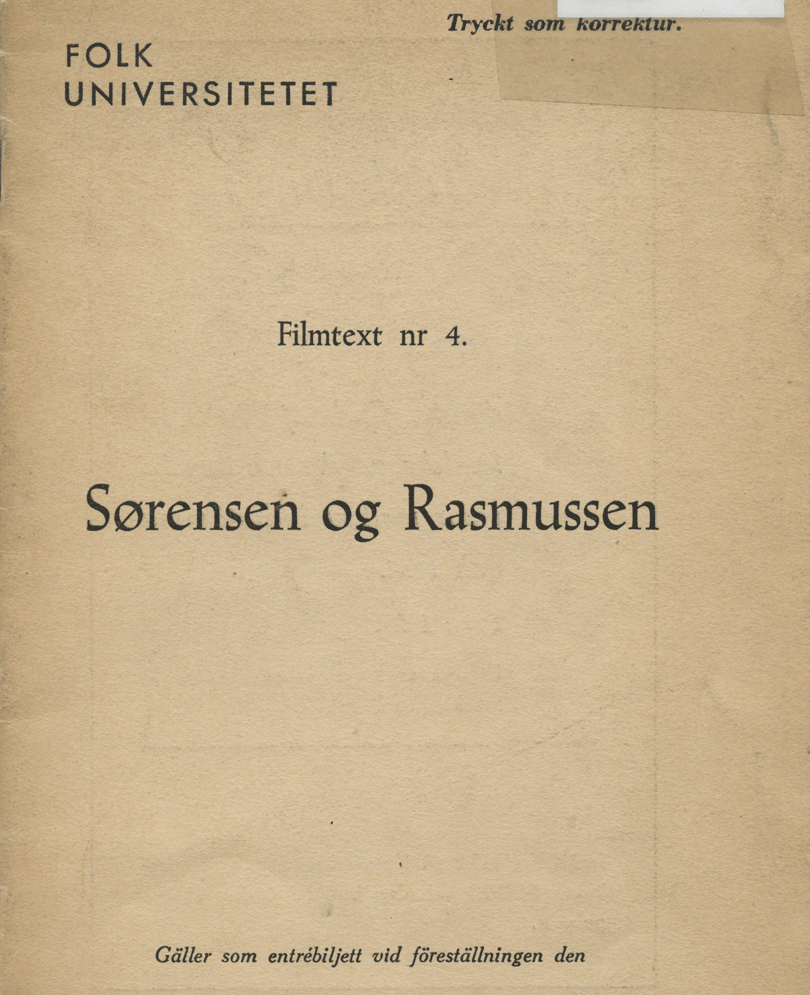
At the back, there is an extensive glossary, where “Balsambøsse” is glossed as: "luktflaska; här smeknamn "(Lynge n.d., 23).
The idea of “pomander” being used as a term of endearment was apparently felt to be strange enough to warrant explanation. In the radio play version, the husband uses it frequently, and at one point in a manner that suggests it refers to Sørensen. Mrs. Parsberg replies: “Is she to be called pomander too? Don’t do that. If I have had to get used to that peculiar expression of your marital love, at least I want exclusive rights to it” (Rosenkrantz 1939, 14). The wife’s hostile response, which we saw in the clip, however, appears only in the movie, not the radio play. It should be noted that the Danish word “balsambøsse” literally means “balm-jar”, giving it an off-color suggestiveness that explains why the wife should find it indecent. The film script plays this up, as we shall see in a moment.
I also think that the use of “balsambøsse” as a term of endearment can plausibly be said to evoke Holberg, and not just because of the anachronism’s distinctiveness. In Sørensen og Rasmussen, like in the opera Maskerade, the experience of role-reversal allows love to flourish. The twists of the film’s plot lead Parsberg and his wife to spend the night in the same bedroom, the door locked from the outside, so that they have to leave by the window the next morning. During the night, Mrs. Parsberg has clearly come to her senses, her haughtiness mostly replaced by a happy recognition of the joys of marriage.
Clip: Sørensen og Rasmussen (Emanuel Gregers, Nordisk Films Kompagni, 1940).
The risqué innuendo involved in Mrs. Parsberg’s embrace of being called “balsambøsse” is not present in Rosenkrantz’s radio play. Lynge’s screenplay is thus not only more populist and democratic than the radio version, but also naughtier. Probably both elements contributed to its popularity.
Ministerial Misgivings
Soon after the Danish premiere, a German correspondent wrote glowingly about Sørensen og Rasmussen. The newspaper clippings scrapbooks maintained at Nordisk contain a clipping from a German paper, unfortunately without giving the source or the date of publication (NF XIV, 22). The article, written by Paul Baumgarten, carries the dateline “Copenhagen, early October” (1940) and is entitled “Der Eisbär lebt noch” – “The Polar Bear Still Lives.” It begins by looking back to the early silent period, when Nordisk’s films – with their logo of a polar bear standing on top of the globe – enjoyed world-wide popularity and a dominant position on the German market. Denmark was slow to convert to sound, however, and the Danish film industry was left behind technologically, its shortcomings seemingly insurmountable. Yet now, the writer argues, Nordisk has released a film that seems to herald “a turn and a rebirth.” The film is Sørensen og Rasmussen. In the Rasmusina scene, Bodil Ipsen “elevates the comedy film to the highest level of art.” Baumgarten continues: “Had the language not put up a barrier likely to be insurmountable -- since this and other scenes do not allow themselves to be "translated" -- the film with Bodil Ipsen would surely begin a triumphal progress around the world, as the Danish silent film with Asta Nielsen did in its day.”
Nordisk would surely have liked their films to be international successes. Lars-Martin Sørensen has pointed out how Carl Bauder, Nordisk’s biggest stockholder and de facto head, gave press interviews in the summer of 1940 about how he hoped the company could break into the huge German market (Sørensen 2014, 126-28). There is no indication that the Danish government was in any way opposed to such efforts in general, but in the particular case of Sørensen og Rasmussen, the Ministry of Justice (the ministry with responsibility for the film industry) made clear that it did not want Nordisk to export the film to Germany.
The Nordisk company files include a letter, dated 8 April 1941, from the ministry to Carl Bauder, the head of the company. It reads: “Upon request I can herewith confirm that the Ministry of Justice has recommended to you that the film ”Sørensen og Rasmussen“ not be sold to Germany and Holland, and that you have declared to the Ministry of Justice your acceptance hereof.” (NF XIII, 5:1).
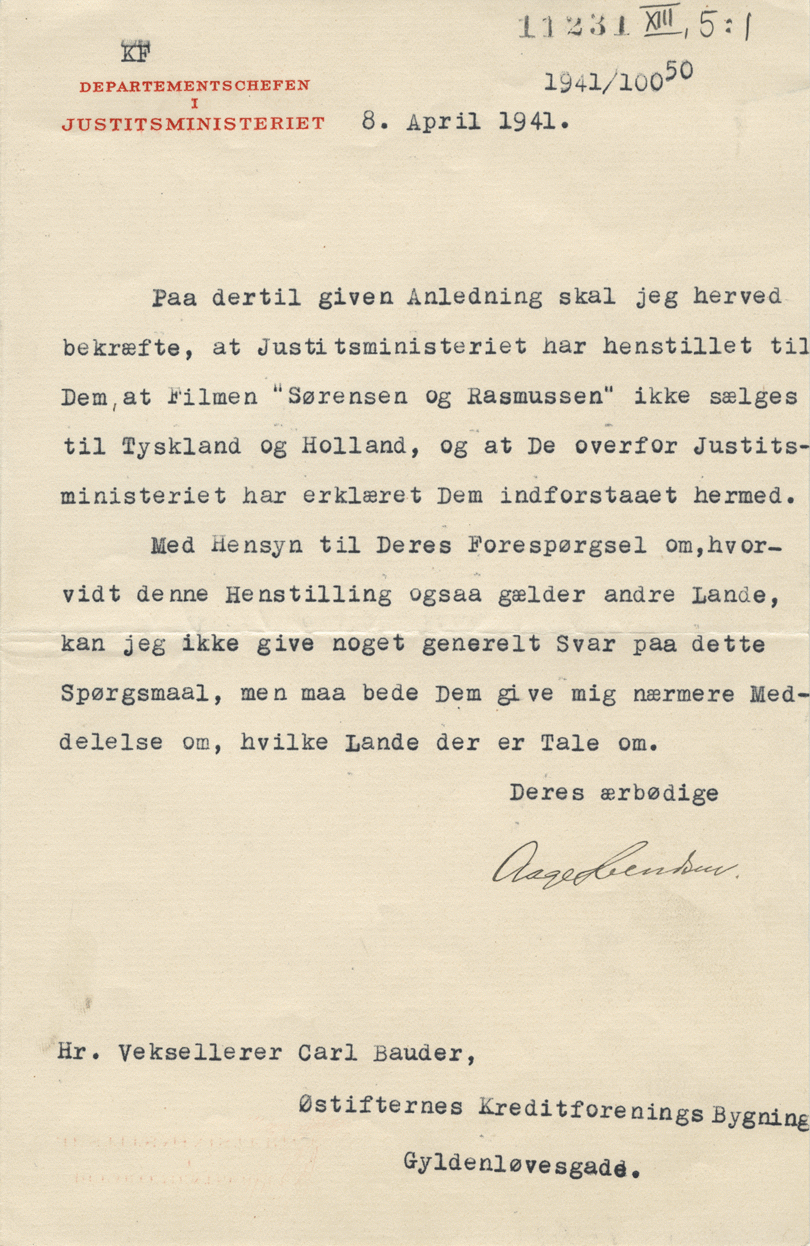
The files of the Ministry of Justice are slightly less circumspect in their wording: the case has been entered as “Ban on the export of the film Sørensen og Rasmussen to Germany and other countries”: a ban, not just a recommendation (RA: Justitsministeriet, 2. Kontor, Journal 1941 100-115). The ministry files do not contain anything that might indicate why such a ban was put in place, but it is clear that it was not an openly declared order. The case file, apart from drafts of the letter to Bauder, contains some handwritten notes concerning meetings or telephone conversations with Bauder (RA: Justitsministeriet, 2. Kontor/Journalsager 5018, j.nr. 1941/100, 50). The first note, dated 27 March 1941, states that Bauder has asked whether the “‘ban’” (quotation marks in original) against exporting Sørensen og Rasmussen to Germany also applies to other countries, particularly Holland – in Bauder’s estimation, “Holland = Germany.” (Exporting the film to Britain, while technically legal, would have been unacceptable to the Germans.)
The higher-ups evidently agreed. A marginal scribble (also dated 27 March) reads, “Not fortunate.” – presumably referring to the idea of exporting the film to Holland. Bauder gets his reply on 3 April. “He is completely willing to follow the ministry’s directives,” according to the notes, but he asked for something in writing to show the company’s board of directors: “it involves, according to him, a not insignificant amount of money for the company.” Another marginal scribble reads, “Seems fair,” and the letter is sent a few days later.
The documents do not reveal why the ministry intervened in this matter. We may speculate that the civil servants may have worried that a film making a Danish king into a figure of fun would give the Germans the wrong impression; the occupiers were punctilious about treating the Danish king with all the proper formalities and courtesies, and mockery of authority figures seems to have been generally unwelcome in Nazi Germany. On the other hand, a film that joyfully anticipated the day when Sørensen and Rasmussen would be running the show might also have seemed the wrong kind of signal to send to Berlin.
Conclusion
The full-colour poster for the film uses the colours of the Danish flag, and this may not have been entirely accidental.
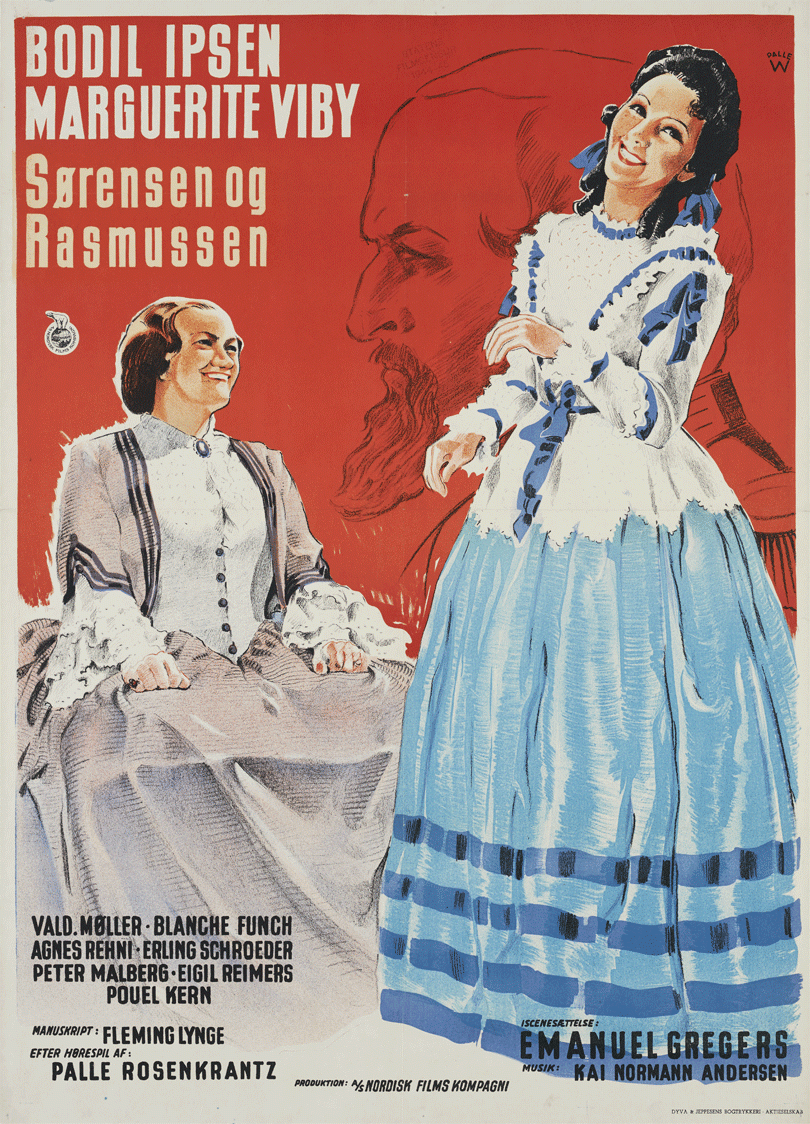
As we have seen, the film shows its nationalist colours in various ways: it not only features idyllic rural landscapes and a story from the nation’s history; to a greater extent than the radio play on which it is based, it evokes Denmark’s democratic destiny. Through the use of plot devices and particularly the word “pomander,” it associates itself with the national comedy tradition. We cannot say exactly why the Danish Ministry of Justice prohibited the exportation of the film to Germany and its satellites, but the most plausible reason would seem to be that the film’s democratic nationalism and ribald, anti-authoritarian tone was felt to be potentially offensive to the occupying power. Along with the bravura comedy performances of Marguerite Viby and Bodil Ipsen, the nationalist undertone surely contributed to the film’s great popularity in occupied Denmark.
Archival sources
RA: Rigsarkivet (Danish State Archive), Copenhagen
DFI: Danish Film Insitute, Copenhagen
NF: Nordisk Film Kompagni company files, DFI, Copenhagen
Newspaper articles found in the DFI clippings file on Sørensen og Rasmussen, the Nordisk company scrapbooks (NF XIV, 22), and the Royal Library, Copenhagen.
Literature
Agger, Gunhild (1984). "Det store publikum." In Dansk litteraturhistorie, 189-220. Copenhagen, Gyldendal.
Andersen, Jens Kristian (2001). "Holberg, Ludvig." In John Chr. Jørgensen (ed.): Dansk forfatterleksikon: Biografier, 192-193. Copenhagen, Rosinante. Andersen, Vilhelm (1941). "Et Glimt." Masken. Tidsskrift for Teater, Musik og Film, July-August, 49-50.Bondebjerg, Ib (1995). "Filmen under besættelsen." In Eva Friis (ed.): Kunst under krigen, 90-105. [Copenhagen], Statens Museum for Kunst.Helstrup-Andersen, Olav (1940). "Sørensen og Rasmussen." Randers Dagblad, 29 October."Historien: sådan startede det hele" (n.d.). Available from http://skanderupefterskole.dk/skanderup/historien/ [accessed 28 October 2014].Jensen, Jørgen I. (1991). Carl Nielsen: Danskeren. Musikbiografi. Copenhagen, Gyldendal.Jørholt, Eva (2001). "1940-49: Voksen, følsom og elegant." In Peter Schepelern (ed.): 100 års dansk film, 121-164. Copenhagen, Rosinante.Lynge, Fleming (n.d.). Sørensen og Rasmussen. Stockholm, Folkuniversitetet.Meldgaard, Eva Villarsen (2008). "Efternavnets historie". Afdeling for Navneforskning. Available from http://nfi.ku.dk/publikationer/webpublikationer/ddsoefternavnetshistorie.pdf [accessed 26 October 2014].Mørk, Ebbe (2001). Marguerite Viby: det var sjovt at være til. Copenhagen, Politiken."personnavn" (2009). Available from http://www.denstoredanske.dk/Sprog,_religion_og_filosofi/Sprog/Navne/Personnavn [accessed 26 October 2014].Piil, Morten (2008). Gyldendals danske filmguide. Copenhagen, Gyldendal.Rosenkrantz, Palle. 1939. Sørensen. Typescript. Royal Library.Sørensen, Lars-Martin (2014). Dansk film under nazismen. Copenhagen, Lindhardt og Ringhof.
Wölfflin, Heinrich (1991). "Eine Revision von 1933 als Nachwort." In Kunstgeschichtliche Grundbegriffe: Das Problem der Stilentwicklung in der neueren Kunst, 276-282. Basel, Schwabe & Co. Original edition, 1933.
Suggested citation
Tybjerg, Casper (2015): The National Pomander: Sørensen og Rasmussen (1940). Kosmorama #260 (www.kosmorama.org)
CASPER TYBJERG / ASSOCIATE PROFESSOR
DEPARTMENT OF MEDIA, COGNITION AND COMMUNICATION
UNIVERSITY OF COPENHAGEN
